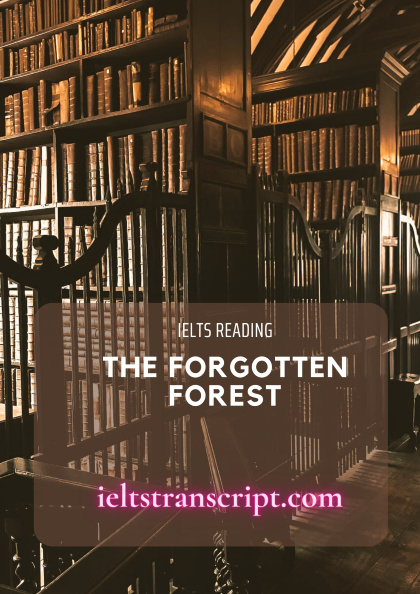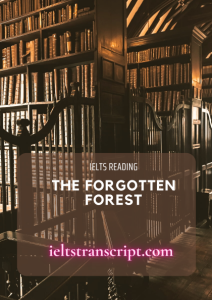- Đối với sản phẩm có giá: Sau khi chúng tôi ghi nhận thông tin đã thanh toán sản phẩm của bạn, sản phẩm sẽ được mở khóa và bạn có thể xem trực tiếp và tải tài liệu sản phẩm.
- Đối với thành viên trả phí: Bạn có thể mua và thanh toán sản phẩm với giá 0đ để tải tài liệu sản phẩm.
- Bạn có thể liên hệ với chúng tôi để được hỗ trợ mở khóa sản phẩm sớm nhất.
The Forgotten Forest
- Chúng tôi chấp nhận các phương thức thanh toán sau đây: Thẻ tín dụng, thẻ ghi nợ, PayPal, chuyển khoản ngân hàng và tiền mặt.
Chúng tôi sẽ không thu thêm phí cho bất kỳ hình thức thanh toán nào.
- Nếu bạn gặp vấn đề về sản phẩm của chúng tôi trong thời gian sử dụng, vui lòng liên hệ với chúng tôi để được hỗ trợ xử lý sớm nhất nhé.
Xem trước mẫu
The Forgotten Forest
Found only in the Deep South of America, longleaf pine woodlands have dwindled to about 3 percent of their former range, but new efforts are under way to restore them.
THE BEAUTY AND THE BIODIVERSITY of the longleaf pine forest are well-kept secrets, even in its native South. Yet it is among the richest ecosystems in North America, rivaling tallgrass prairies and the ancient forests of the Pacific Northwest in the number of species it shelters. And like those two other disappearing wildlife habitats, longleaf is also critically endangered.
In longleaf pine forests, trees grow widely scattered, creating an open, parklike environment, more like a savanna than a forest. The trees are not so dense as to block the sun. This openness creates a forest floor that is among the most diverse in the world, where plants such as many-flowered grass pinks, trumpet pitcher plants, Venus flytraps, lavender ladies and pineland bog-buttons grow. As many as 50 different species of wildflowers, shrubs, grasses and ferns have been cataloged in just a single square meter.
Once, nearly 92 million acres of longleaf forest flourished from Virginia to Texas, the only place in the world where it is found. By the turn of the 2lst century, however, virtually all of it had been logged, paved or farmed into oblivion. Only about 3 percent of the original range still supports longleaf forest, and only about 10,000 acres of that is uncut old-growth—the rest is forest that has regrown after cutting. An estimated 100,000 of those acres are still vanishing every year. However, a quiet movement to reverse this trend is rippling across the region. Governments, private organisations (including NWF) and individual conservationists are looking for ways to protect and preserve the remaining longleaf and to plant new forests for future generations.
Figuring out how to bring back the piney woods also will allow biologists to help the plants and animals that depend on this habitat. Nearly two-thirds of the declining, threatened or endangered species in the southeastern United States are associated with longleaf. The outright destruction of longleaf is only part of their story, says Mark Danaher, the biologist for South Carolina’s Francis Marion National Forest. He says the demise of these animals and plants also is tied to a lack of fire, which once swept through the southern forests on a regular basis. “Fire is absolutely critical for this ecosystem and for the species that depend on it,” says Danaher.
Name just about any species that occurs in longleaf and you can find a connection to fire. Bachman’s sparrow is a secretive bird with a beautiful song that echoes across the longleaf flatwoods. It tucks its nest on the ground beneath clumps of wiregrass and little bluestem in the open under-story. But once fire has been absent for several years, and a tangle of shrubs starts to grow, the sparrows disappear. Gopher tortoises, the only native land tortoises east of the Mississippi, are also abundant in longleaf. A keystone species for these forests, its burrows provide homes and safety to more than 300 species of vertebrates and invertebrates ranging from eastern diamond-back rattlesnakes to gopher frogs. If fire is suppressed, however, the tortoises are choked out. “If we lose fire,” says Bob Mitchell, an ecologist at the Jones Center, “we lose wildlife.”
Without fire, we also lose longleaf. Fire knocks back the oaks and other hardwoods that can grow up to overwhelm longleaf forests. “They are fire forests,” Mitchell says. “They evolved in the lightning capital of the eastern United States.” And it wasn’t only lightning strikes that set the forest aflame. “Native Americans also lit fires to keep the forest open,” Mitchell says. “So did the early pioneers. They helped create the longleaf pine forests that we know today.”
Fire also changes how nutrients flow throughout longleaf ecosystems, in ways we are just beginning to understand. For example,
...
Khu rừng bị lãng quên
Được phát hiện ở khu vực Deep South tại Mỹ, rừng thông lá dài đã bị thu hẹp còn khoảng 3% so với phạm vi trước đây, nhưng những nỗ lực mới đang được tiến hành để khôi phục chúng.
VẺ ĐẸP VÀ TÍNH ĐA DẠNG SINH HỌC của rừng thông lá dài là những bí mật được giấu kín, ngay cả ở quê hương miền Nam của chúng. Dù vậy, chúng là một trong những hệ sinh thái phong phú nhất ở Bắc Mỹ, sánh ngang với các thảo nguyên cỏ cao và các khu rừng cổ ở Tây Bắc Thái Bình Dương về số lượng các loài mà chúng che chở. Và giống như hai môi trường sống hoang dã khác đang dần biến mất, cây lá dài cũng đang ở mức cực kỳ nguy cấp.
Trong các khu rừng thông lá dài, cây cối mọc thưa thớt rộng rãi, tạo ra một môi trường thoáng đãng, giống như công viên hay đồng cỏ hơn là một khu rừng. Cây cối không quá rậm rạp để gây cản ánh nắng mặt trời. Không gian thoáng đãng này tạo ra tầng lớp rừng thuộc loại đa dạng nhất trên thế giới, nơi các loài thực vật sinh trưởng như lan cỏ hồng nhiều hoa, các loại cây nắp ấm loa kèn, cây Venus bẫy mồi, hoa oải hương và cây hoa hình nút áo (pineland bog-buttons). Có tới 50 loài hoa dại, cây bụi, cỏ và dương xỉ khác nhau đã được đưa vào danh mục xuất hiện chỉ trong phạm vi một mét vuông.
Đã từng có gần 92 triệu mẫu rừng cây lá dài nở rộ khắp từ Virginia đến Texas, nơi duy nhất trên thế giới mà chúng được tìm thấy. Tuy nhiên, vào đầu thế kỷ 21, hầu như tất cả chúng đã bị khai thác, làm đường hoặc lấy đất trồng trọt. Chỉ khoảng 3% diện tích ban đầu vẫn còn rừng lá dài, và chỉ khoảng 10.000 mẫu trong số đó là rừng già chưa từng bị khai thác – phần còn lại là rừng mọc lại sau khi chặt. Ước tính khoảng 100.000 mẫu trong số đó vẫn đang dần biến mất sau mỗi năm. Tuy nhiên, động thái âm thầm để đảo ngược xu hướng này đang từ từ diễn ra trên khắp khu vực. Chính phủ, các tổ chức tư nhân (bao gồm NWF) và các nhà hoạt động vì môi trường đang tìm cách bảo vệ và bảo tồn những cây lá dài còn lại và trồng các khu rừng mới cho thế hệ tương lai.
Tìm ra cách phục hồi rừng họ thông cũng sẽ cho phép các nhà sinh vật học cứu các loài động thực vật phụ thuộc vào môi trường sống này. Gần 2/3 số loài đang suy giảm, bị đe dọa hoặc có nguy cơ tuyệt chủng ở đông nam Hoa Kỳ có mối liên hệ với cây lá dài. Mark Danaher, nhà sinh vật học tại rừng quốc gia Francis Marion ở Nam Carolina, nói: “Việc tàn phá hoàn toàn cây lá dài chỉ là một phần trong câu chuyện của chúng. Ông cho biết sự biến mất của những loài động vật và thực vật này cũng liên quan đến tình trạng thiếu lửa, từng thường xuyên quét qua các khu rừng phía nam. Danaher nói: “Lửa là cực kỳ quan trọng đối với hệ sinh thái này và đối với các loài phụ thuộc vào chúng.
Nhắc đến bất kỳ loài sinh vật nào xuất hiện trong hệ sinh thái của cây lá dài, bạn đều có thể tìm thấy mối liên hệ với lửa. Chim sẻ Bachman là một loài chim bí ẩn, giọng hót tuyệt vời của chúng vang vọng khắp các khu rừng lá dài. Chúng giấu tổ xuống dưới đất bên dưới những đám cỏ dây (wiregrass) và một ít cỏ cao ở tầng cây dưới thấp thoáng đãng. Nhưng khi mà lửa đã vắng bóng trong vài năm, và những lùm cây bụi bắt đầu mọc lên hỗn độn, chim sẻ dần biến mất. Rùa Gopher, loài rùa cạn bản địa duy nhất ở phía đông Mississippi, cũng sống nhiều ở hệ sinh thái cây lá dài. Là loài chủ chốt ở những khu rừng này, hang của chúng cung cấp chỗ trú ẩn an toàn cho hơn 300 loài động vật có xương sống và không xương sống, từ rắn đuôi chuông lưng kim cương phía đông cho đến ếch gopher. Tuy nhiên, nếu lửa bị chặn lại, rùa sẽ thiếu không khí để thở. Bob Mitchell, một nhà sinh thái học tại Trung tâm Jones, nói: “Nếu lửa không còn, chúng ta sẽ mất đi các loài hoang dã”.
Không có lửa, chúng ta cũng mất cây lá dài. Lửa sẽ đẩy lui sồi và các loại cây gỗ cứng khác có khả năng phát triển lấn át các khu rừng cây lá dài. “Chúng là những khu rừng lửa,” Mitchell nói. “Chúng đã tiến hóa ở kinh đô sấm sét của miền đông Hoa Kỳ.” Và không chỉ có những tia sét mới đốt cháy các khu rừng. Mitchell nói: “Những người thổ dân bản địa cũng đốt lửa để giữ cho khu
...Để xem được đầy đủ nội dung và tải dữ liệu, bạn phải trở thành thành viên của chúng tôi và trả phí cho tài liệu (nếu có)











